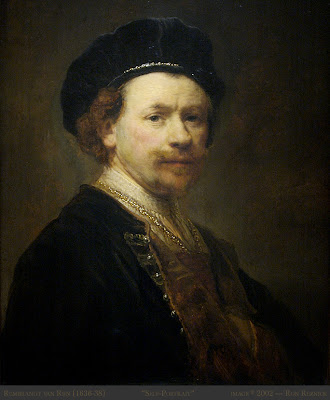In a book on symbolism the author uses a very broad definition of symbol claiming that any depiction of objects in a painting stands for something outside of the work of art and therefore they all are symbols. Thus a guitar in a painting "symbolizes" a guitar, hand is a "symbol" of a human hand. This is wrong: he confuses "illusion" with "symbols". An object portrayed in a painting is an illusion of an object that exists outside of a painting but once it is successfully painted it has gained its sovereignty. Now it becomes a positive, complete being on its own : an image that in many important ways differs from its origins in the outside world. There is an ontological difference between a painted guitar and a guitar: one is an apparition, an image made of light, while the other is a material being. Symbols exist differently: they are members of the mind’s library of symbolic meanings.
Sebastian Stosskopf :Vanitas still life
Sebastian Stosskopf :Vanitas still life
A scull symbolizes death but the depiction of the scull shows us an illusion of a scull, not a symbol of it. One is visual the other is rational: Imago and Logos. Images are viewed while symbols are read. To apprehend the scull as a symbol of death one has to stop contemplating it as an image and engage in reading the logos of the scull, as a category of thought, not an image anymore.
The image requires of the viewer only a cursory acquaintance with the visible world to come into being. One does not have to know what a guitar looks like to recognize it in a painting as some string instrument and allow the arrangement of paints to become an image of a guitar. For the symbol to come into existence a pictogram of an object has to occur and be recognized by the viewer’s library of symbolic meanings. So, the crossbones and scull do not have to be depicted with any attempt at accuracy to serve as a pictogram indicating a symbol of death. Indeed the individuating elements of the image are impeding and have to be overlooked, peeled away to show more succinctly the "noun" to be read and compared with the mind's library of symbols. Vertical bar in a child's depiction of a face is a pictogram of a nose and is "read" as a symbol of the noun "nose". At that point the child is no longer a painter, but a writer, hieroglyphic writer.
Joan Miro : "Girl"
Joan Miro : "Girl"
Kandinsky, Miro and at times Klee were writers of new kind of pictograms; playful pictograms without clues, fake cryptograms where wish to communicate has been replaced by an illusory meaningfulness.
Fragment of "Betrothal of Arnolfini" by Jan Van Eyck
Symbolic language enjoys considerable popularity among art critics who love to discover symbols everywhere. That means more than reading the handful of symbols placed by the artists but going on their own Symbol Safari and discovering new ones, placed in artworks by the "subconsciousness". Yet language of symbols is not a rich, dynamic, expressive, mentally rewarding form of communication. It is static, stale, reminiscent of what first attempts at any language could have been. The message in most cases is like a few one-word placards propped against each other. Not a very good tool for conveying anything of complexity, subtlety or uniqness. Yet, symbolic interpretations of art-works are generating longest texts full of exaggerated constructs and conjurer’s tricks of ideological fancy wholly unwarranted by the simple image that served as a bottom stool for the ridiculous overreaching into the stratosphere of cheap ideas. Since the art critics and art historians naturally tend toward the world of ideas rather than close contemplation they look with impatient distraction at the language of representation and dismiss it as narrowly literal. Oh, Rembrandt -shame on you for painting all those self-portraits without a nail to hang a symbol on!
Rembrandt van Rijn
Rembrandt van Rijn
In contrast language of representation with its directness, immediacy and irreducible complexity feeds and rewards the viewer in a way that can never be fully exhausted, cannot be dipped-out to its bottom. Yet, because images exist on the outside of discrete language, they don’t generate much text under the fingers of art commentators. What is so importantly, manifestly there remains uncanny, in plain view but appealing to viewer’s intimate acquaintance with directly experienced reality rather than covering the resplendent nakedness of images with rancid rags of concepts.




Thank you for another thought-provoking essay with excellent writing and fine examples. I saw this happening in the 1980's at university. What some professors didn't realize was that a cultural landslide was burying "resplendence" under a mountain of decadence and lethargy. Now that I am old enough to see deconstruction in decline, it is shocking to observe the ignorance evident in it's wake-- behind which lies so much indifference toward the past, and consequently to what is real, beautiful, and "symbolic" in it truest sense. We are now in chaos, but thanks to your clearheaded arguments and thoughtful examples I know there’s still hope for a cultural future where maturity and respect can return to the arts.
ReplyDelete